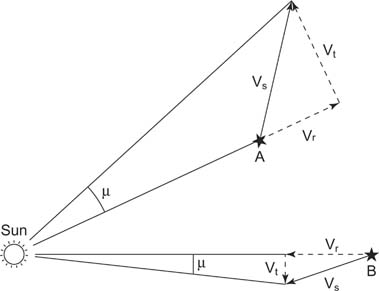Proper Motions and Radial Velocities
Radial velocity (measured in km/s) is the velocity along the line of sight away from (considered a positive velocity) or toward (negative velocity) the observer. (Astronomers actually correct observed motions for that of Earth, hence recorded velocities are relative to the Sun.) Radial velocity is determined from the Doppler effect in the spectra of the stars. Of the nearby stars, some are moving toward us and others are moving away—there is no indication of systematic collapse or expansion of the Galaxy.
Proper motion is the rate of angular drift across the sky (measured in arc seconds per year) and is found from the star's change of position on the sky (see Figure ). It is related to a star's transverse velocity (km/s; the velocity component of the star parallel to the plane of the sky) depending upon the distance to the star. Proper motions are small; Barnard's star, which has the largest known proper motion of 10.31″/yr, would take 175 years to drift an angular distance equal to the diameter of the full Moon.

Figure 1 Proper motion and space motion. The Doppler effect gives us the radial velocity Vr
toward (star B in this example) or away (star A) from the Sun. Each star's proper motion μ
combined with its distance yields the transverse velocity Vt. The hypotenuse of the right angle
triangle formed by Vr and Vt is the true space motion Vs of each star.
Nearby stars have relatively large proper motions and, in fact, that is how these stars have generally been found. More distant stars have smaller proper motions, hence the distant stars can be thought of as “fixed.”
Combining the radial motion toward or away from the Sun with a star's transverse motion at right angles to the line of sight yieldes the star's space motion (or true motion), a speed in km/s and a direction relative to the Sun.